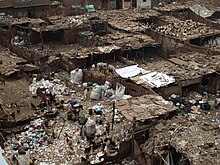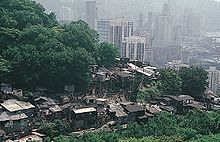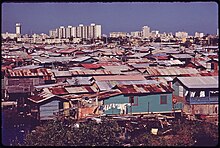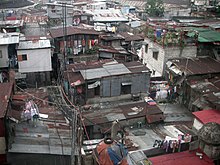From Wikipedia
- "Shantytown" and "Hutment" redirect here. For the created gold-mining town in New Zealand, see Shantytown, New Zealand.
See also: Slum
Shanty town in Soweto, South Africa, 2005
A shanty town or squatter area is a settlement of plywood, corrugated metal, sheets of plastic, and cardboard boxes. Such settlements are usually found on the periphery of cities, in public parks, or near railroad tracks, rivers, lagoons or city trash dump sites. Sometimes called a squatter, informal or spontaneous settlement, a typical shanty town often lacks proper sanitation, safe water supply, electricity, hygienic streets, or other basic human necessities.
Shanty towns are mostly found in developing nations, but also in some parts of developed nations.[1][2][3]
Etymology
A shanty town in Jakarta, Indonesia
Shanty is probably from Canadian French chantier, a winter station established for the organization of lumberjacks.[4]
Hutment means an "encampment of huts". When the term is used by the military, it means "temporary living quarters specially built by the army for soldiers".[5] The term is also a synonym for shanty town, particularly in developing countries.
Features
Shanty towns sometimes have an active informal economy,
such as garbage sorting, pottery making, textiles and leather works.
This allows the poor to earn a livelihood. The above shanty town image
is from Ezbet Al Nakhl, in Cairo Egypt, where garbage is sorted manually. Residential area is visible at the top of the image.
Since construction is informal and unguided by urban planning, there is typically no formal street grid, numbered or named streets. Such settlements also lack some or all basic public services such as a sewage network, electricity, safe running water, rain water drainage, garbage removal, access to public transport, insect and disease control services. Even if these resources are present, they are likely to be disorganized, unreliable and poorly maintained. Shanty towns also tend to lack basic services present in more formally organized settlements, including policing, mail delivery, medical services and fire fighting. Fires are a particular danger for shanty towns not only for the lack of fire fighting stations and the difficulty fire trucks have traversing the settlement in the absence of formal street grids,[6] but also because of the high density of buildings and flammability of materials used in construction.[7] A sweeping fire on the hills of Shek Kip Mei, Hong Kong, in late 1953 left 53,000 dwellers homeless, prompting the colonial government to institute a resettlement estate system.
Shanty towns have high rates of crime, suicide, drug use and disease. However, Swiss journalist Georg Gerster has noted (with specific reference to the invasões of Brasilia) that "squatter settlements [as opposed to slums], despite their unattractive building materials, may also be places of hope, scenes of a counter-culture, with an encouraging potential for change and a strong upward impetus".[8] Stewart Brand has also written, more recently, that "squatter cities are Green. They have maximum density—a million people per square mile in Mumbai—and minimum energy and material use. People get around by foot, bicycle, rickshaw, or the universal shared taxi ... Not everything is efficient in the slums, though. In the Brazilian favelas where electricity is stolen and therefore free, Jan Chipchase from Nokia found that people leave their lights on all day. In most slums recycling is literally a way of life." (2010)[9]
Examples
A shanty town near Cape Town, South Africa. These slums were built by the apartheid
era government to segregate people by color and ethnic origin. The
above Khayelitsha Township is Africa's largest, with shanty homes served
with disorganized electrical lines, with one shed showing a car parked
inside.
Developing countries
Shanty towns are present in a number of countries. The largest shanty town in Asia is Orangi in Karachi, Pakistan.[10] In francophone countries, shanty towns are referred to as bidonvilles (French for "can town" - can being a reference to tin metal); such countries include Tunisia and Haiti. Other countries with shanty towns include South Africa (where they are often called Townships) or imijondolo, Kenya (including the Kibera and Mathare slums), the Philippines (often called squatter areas), Venezuela (where they are known as barrios), Brazil (favelas), Argentina (villas miseria), West Indies such as Jamaica and Trinidad and Tobago (where they are known as Shanty town), and Peru (where they are known as "young towns"). In Russia, shanty towns - called truščóba (трущобы) - are present in smaller cities as well in Chelobityevo outside Moscow.[11][12] There is also a major shanty town population in countries such as Bangladesh,[13] and the People's Republic of China.[14][15][16]
Developed countries
Although shanty towns are less common in developed countries, there are some cities that have them. While shanty towns are less common in Europe, the growing influx of illegal immigrants have fueled shantytowns in cities commonly used as a point of entry into the EU, including Athens and Patras in Greece.[17] In Madrid, Spain, a low-class neighborhood named Cañada Real (which is considered a shanty town) has no formal education system, professional nurseries or modern health clinics and is considered the largest slum in Europe.[18] In Portugal, shanty towns known as "barracas" or "bairros de lata" are made up of immigrants from former Portuguese African colonies and Roma from Eastern Europe. Most of them are located in Lisbon Metropolitan Area. In the United States, some cities such as Newark and Oakland have witnessed the creation of tent cities. Other settlements in developed countries that are comparable to shanty towns include the Colonias near the border with Mexico, and bidonvilles in France, which may exist in the peripheries of some cities.
In some cases, shanty towns can persist in gentrified areas that local governments have yet to redevelop, or in regions of political dispute. Examples of this include Ras Khamis in Israel and the Kowloon Walled City in Hong Kong.
Development
Shanty towns may be large or small settlements. Above shanty town is in Hong Kong.
An impoverished American family living in a shanty during the Great Depression. Photographed by Dorothy Lange in 1936
Shanty town along the Martin Pena Canal in Puerto Rico, United States (1970s).[1]
Regional names
Chabolas a plomo - shanty town perched on the side of a steep mountain in Latin America.
Dharavi shanty town in Mumbai, India.
- Asentamientos in Guatemala
- Baraccopoli in Italy
- Paraggoupoli in Greece
- Barrios de invasión in Colombia
- Malin Basti or Zopadpatti in India
- Invasiones in Ecuador
- Bidonvilles in France
- Campamentos or poblaciones callampa in Chile.
- Cantegriles (or more recently, Asentamientos) in Uruguay
- Chabolas in Spain
- Colonias or "Migrant camps" on the Mexico – United States border
- Favelas in Brazil
- Gecekondu in Turkey
- Hoovervilles in the United States (historical)
- Gueto in Puerto Rico
- Llegaipon in Cuba
- Poblados chabolistas in Spain
- Pueblos jóvenes (young towns) or barriadas in Peru
- Putri in Hungary
- Ranchos in Venezuela
- Squatter Camp in South Africa[26]
- Tent cities, Trailer Parks in the United States
- Tugurios or precarios in Costa Rica
- Villas Miseria or just villas in Argentina
- Zona marginal or ciudad perdida in Mexico
- Ghetto in Panama
- السكن العشوائي Al Sakan Al Ashawayie in Syria
Specific places
Shanty town by a canal in Ho Chi Minh City, Vietnam.
- Favela da Rocinha (Rio de Janeiro, Brazil)
- see also List of favelas in Brazil
- Cité Soleil (Haiti)
- Dharavi (India)
- Joe Slovo (Cape Town, South Africa)
- Kibera (Nairobi, Kenya)
- Mathare (Nairobi, Kenya)
- Khayelitsha (Cape Town, South Africa)
- Kya Sands (Johannesburg, South Africa)
- Ciudad Bolivar (Bogota, Colombia)
People and organizations
A shanty town in Manila, Philippines.
- Abahlali baseMjondolo (South Africa)
- Akhtar Hameed Khan
- CEIFAR
- Hernando de Soto (economist)
- Marie Huchzermeyer (scholar)
- Mike Davis (scholar)
- Chinese New Village (Malaysia)
- Orangi Pilot Project
- Slum Dwellers International
- Slum upgrading
- United Nations Human Settlements Programme
- Western Cape Anti-Eviction Campaign
- The Susso, welfare in Australia originating in the Great Depression
- Occupy Wall Street
Related concepts
A riverside shanty town near Dhaka, Bangladesh.
- Dormitory
- Ghetto
- Flophouse
- Favela
- Hobo
- Slumlord
- Poverty in France
- Refugee shelter
- Skid row
- Squatting
- Tent city
- Trailer park
- Urban decay
In popular culture
- The 1985 film Police Story starts off in a shanty town.
- The film Slumdog Millionaire centres around characters who spend most of their lives in Indian shanty towns.
- The South African film District 9 is largely set in (and takes its name from) a fictional Johannesburg township.
- The Brazilian films City of God (set in Cidade de Deus) and Tropa de Elite - and to a lesser extent its sequel, Elite Squad: The Enemy Within - are all largely set in favela shanty towns in Rio de Janeiro, as are the semi-autobiographical novels on which they are based (City of God and Elite da Tropa).
- One of the alternate titles for Demented Death Farm Massacre is Shantytown Honeymoon.
- One of the areas in Resident Evil 5 is located in a shanty town.
- In Max Payne 3 most of the time took place in Nova Esperança, a favela in the city of São Paulo.
- One of the sections of the new Tomb Raider (2013 video game) is located in a shanty town, as part of the single player campaign, and also on one of the multiplayer levels.
- Reggae singer Desmond Dekker sang a song called "007 (Shanty Town)".
- Kibera Kid is an award-winning short film by Nathan Collett set in the Kibera slums of Nairobi, Kenya.
- White Elephant, 2012 Argentinian movie, is set in a villa miseria in Buenos Aires, Argentina
- Miracle in Milan is a 1951 Italian film told as a neo-realist fable of the lives of a poverty-stricken group in post-war Milan, Italy.
- One of the chapters of the Left 4 Dead 2 campaign Swamp Fever, set in a Louisiana bayou village, is called The Shantytown and takes place in a series of patchwork wooden buildings not uncommon for shanty towns.
See also
References
- "SA’s post-apartheid failure in squatter camps". MoneyWeb. Retrieved 18 September 2013.
Further reading
- Daniel Carter Beard (1920). Shelters, shacks, and shanties. C. Scribner's Sons. Retrieved 24 August 2012.
- Slate article about an economist proposing New Orleans to be reconstructed with shanties
External li
| Wikimedia Commons has media related to Shanty towns. |












Δεν υπάρχουν σχόλια:
Δημοσίευση σχολίου